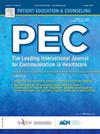马尔代夫儿科医生和患有慢性病的儿童(或其父母)之间的共同决策:一项多中心探索性研究
IF 3.1
2区 医学
Q2 PUBLIC, ENVIRONMENTAL & OCCUPATIONAL HEALTH
引用次数: 0
摘要
共同决策(SDM)在马尔代夫是一个新兴的医疗概念。这似乎特别适用于患有慢性病的儿童,因为他们的许多治疗决定都是随着时间的推移而做出的。在马尔代夫各地的会诊期间,对儿科医生与儿童或其父母之间的SDM水平进行了基线测量,并探讨了可能的影响因素。方法一项多中心横断面观察性研究评估了马尔代夫五家医疗中心的慢性病患儿在获得知情同意后到儿科门诊就诊的情况。两名评估人员独立分析了会诊录音,使用OPTION-5仪器对患者参与决策的程度进行评分。儿科医生和患者(或其父母)分别使用SDM- q - doc和SDM- q -9工具对他们感知的SDM水平进行评分。分数以最高分数的百分比表示。没有儿科医生之前接受过SDM培训。采用多变量线性回归分析确定影响因素。结果对78例问诊进行录音分析。儿童平均年龄为6.6岁(范围:0-15岁)。OPTION-5评分中位数为20 %[四分位间距(IQR) 10-25 %],范围为0 %至55 %。患者和儿科医生的SDM-Q评分中位数分别为96 % (IQR 80-100 %)和84 % (IQR 73-93 %)。回归分析显示,患儿年龄(p = 0.008)、就诊时间(p = 0.004)、就诊中心(p范围:0.003 ~ 0.015)是影响SDM水平的显著独立因素。咨询语言和疾病类别(呼吸、遗传和其他疾病)与医生对儿童/父母参与决策过程的看法显著相关(p <; 0.001)。可持续发展机制在马尔代夫儿科医生和患有慢性病的儿童及其父母中没有得到广泛利用。患者/家长、医院工作人员和政策制定者对SDM的原理、证据和益处的了解有限和不熟悉,以及儿科医生缺乏SDM技能,可能是OPTION-5工具测量的SDM得分相对较低的原因,而不是高感知的SMD水平。在目前的基线研究中观察到的SDM水平为在马尔代夫地区引入这种护理方法提供了机会,在决定治疗方案时,SDM似乎是一种明显的方法。马尔代夫儿科护理的SDM可以通过以下方式得到改善:对SDM的原则和益处进行教育,对儿科医生进行培训以提高SDM的水平,提高治疗风险/收益比沟通技巧,使用决策支持工具帮助慢性病儿童及其护理人员参与SDM过程。已知情况- SDM可以帮助儿童更多地参与儿科医生和家长之间关于他们自己的首选治疗方案以及他们的健康结果的决策过程。−患有慢性疾病的儿童可能受益于SDM,因为需要在疾病过程中做出许多决定。因此,他们在成长过程中应该越来越多地参与治疗决策。有什么新情况-马尔代夫患有慢性病的儿童在决策过程中的参与程度仍有改进的余地。−儿科医生对他们参与慢性病儿童和家长/照顾者的能力的感知高于实际参与SDM过程的水平。本文章由计算机程序翻译,如有差异,请以英文原文为准。
Shared decision-making between pediatricians and children (or their parents) with chronic disease in the Maldives: A multi-center exploratory study
Introduction
Shared decision-making (SDM) is a burgeoning concept of care in the Maldives. It seems especially applicable in chronically ill children, for whom many treatment decisions are made over time. A baseline measurement of the SDM level between pediatricians and children or their parents was carried out during consultations across the Maldives, and possible influencing factors were explored.
Methods
A multi-center cross-sectional observational study assessed children with a chronic disease visiting the pediatric outpatient clinic at five medical centers in the Maldives after obtaining informed consent. Two evaluators independently analyzed audio recordings of the consultations to score the level of patient involvement in decision-making using the OPTION-5 instrument. Pediatricians and patients (or their parents) scored their perceived SDM levels using the SDM-Q-Doc and SDM-Q-9 tools, respectively. Scores were expressed as percentages of the maximum score. No pediatrician received previous SDM training. Multivariable linear regression analysis was utilized to identify the influencing factors.
Results
Seventy-eight consultations were audio recorded and analyzed. The mean children’s age was 6.6 years (range: 0–15 years). The median OPTION-5 score was 20 % [interquartile range (IQR) 10–25 %], ranging from 0 % to 55 %. Patients’ and pediatricians’ median SDM-Q scores were 96 % (IQR 80–100 %) and 84 % (IQR 73–93 %), respectively. Regression analysis indicated that the child’s age (p = 0.008), consultation duration (p = 0.004), and medical center (p range: 0.003–0.015) were significant independent factors influencing the SDM level. Language of consultation and disease categories (respiratory, genetic, and other diseases) were significantly (p < 0.001) associated with the physicians’ perception of child/parent involvement in the decision-making process.
Discussion
SDM is not widely utilized among Maldivian pediatricians and children suffering from chronic diseases and their parents. Limited knowledge and unfamiliarity among the patient/parents, hospital staff, and policy makers about the principle, evidence, and benefits of SDM, as well as the lack of SDM skills among pediatricians, are the likely reasons for the relatively low observed SDM scores as measured by the OPTION-5 tool, as opposed to the high perceived SMD levels.
Conclusions
The observed SDM levels in the present baseline study provided opportunities to introduce this method of care in the Maldives in areas where SDM seems an obvious approach when deciding about treatment options. SDM in Maldivian pediatric care can be improved through education about the principles and benefits of SDM, training to improve the pediatricians’ SDM, treatment risk/benefit ratio communication skills, and decision support tools to help chronically ill children and their caregivers participate in the SDM process.
What is known
- −SDM can help increase children’s involvement in the decision-making process between pediatricians and parents about their own preferred treatment options as well as their health outcomes.
- −Children who suffer from a chronic condition may benefit from SDM as many decisions need to be made during the course of their disease. Hence, they should be increasingly more involved in treatment decision-making while growing up.
What is new
- −The level of participation in the decision-making process in children suffering from chronic diseases in the Maldives leaves room for improvement.
- −Pediatricians’ perception about their ability to involve chronically ill children and parents/caregivers is higher than the actual level of involvement in the SDM process.
求助全文
通过发布文献求助,成功后即可免费获取论文全文。
去求助
来源期刊

Patient Education and Counseling
医学-公共卫生、环境卫生与职业卫生
CiteScore
5.60
自引率
11.40%
发文量
384
审稿时长
46 days
期刊介绍:
Patient Education and Counseling is an interdisciplinary, international journal for patient education and health promotion researchers, managers and clinicians. The journal seeks to explore and elucidate the educational, counseling and communication models in health care. Its aim is to provide a forum for fundamental as well as applied research, and to promote the study of organizational issues involved with the delivery of patient education, counseling, health promotion services and training models in improving communication between providers and patients.
 求助内容:
求助内容: 应助结果提醒方式:
应助结果提醒方式:


